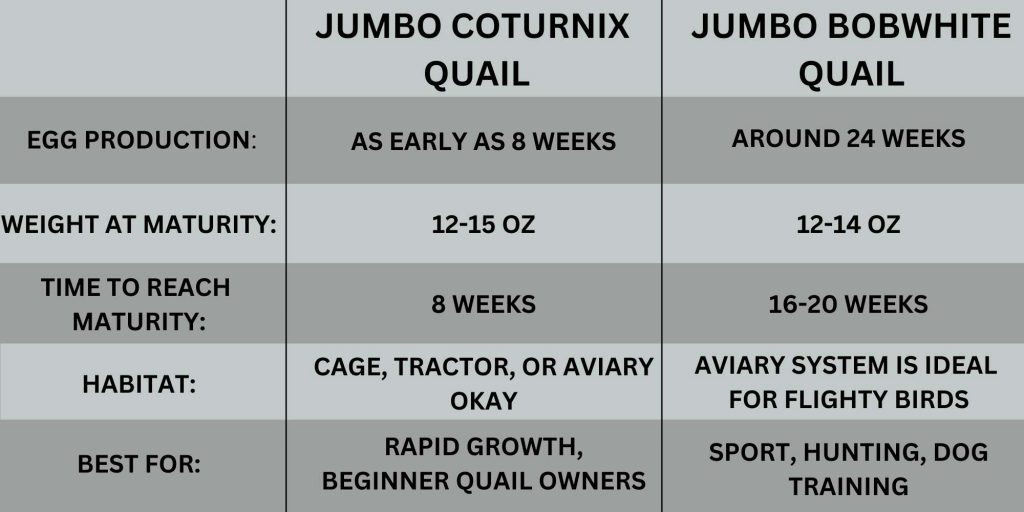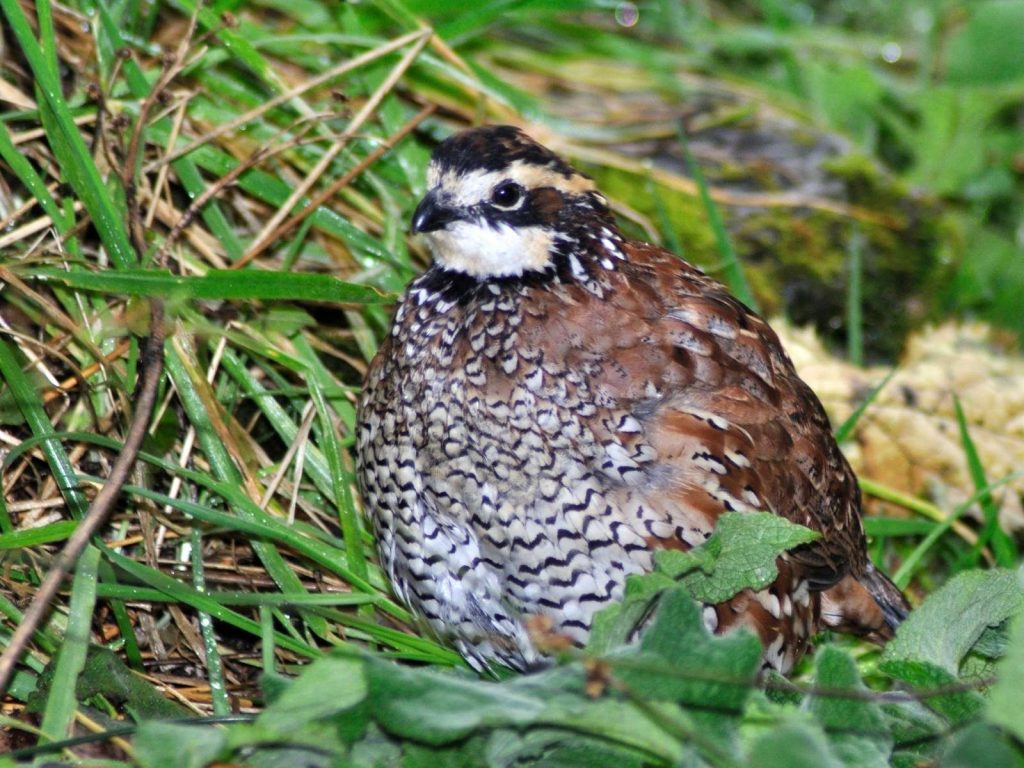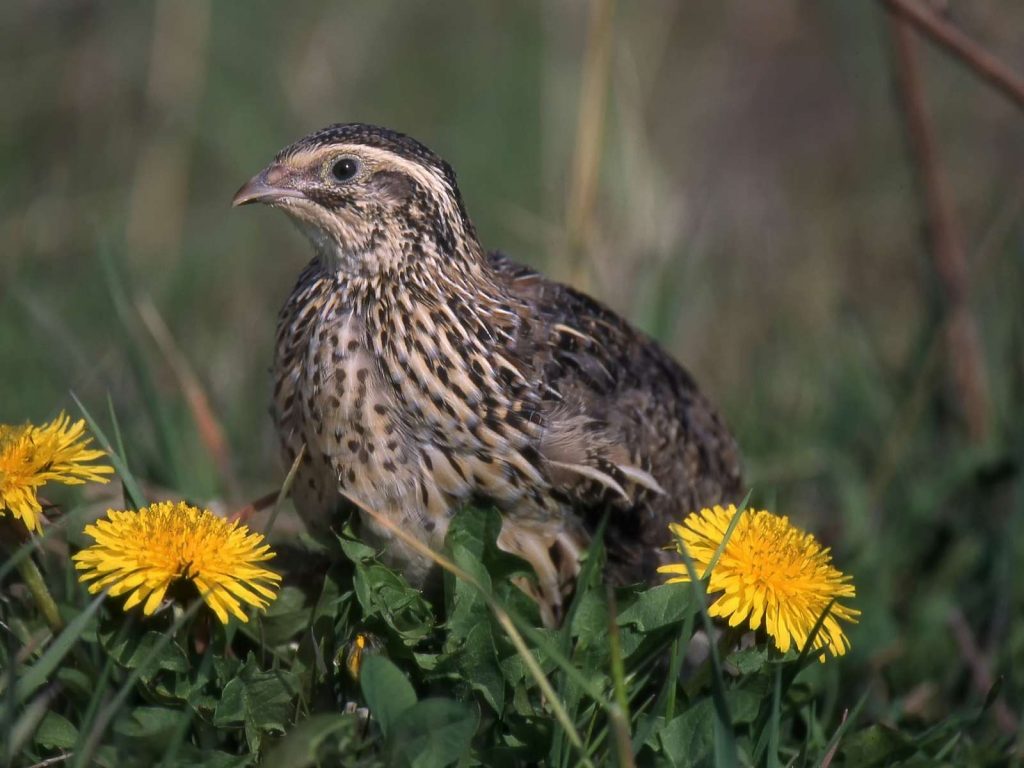Bobwhite VS. Coturnix – The Best Jumbo Quail Breed for Meat
Raising quail at home is an excellent way to establish a sustainable egg and meat source right in your backyard. But what types of quail are most efficient for backyard quail farming? This post will compare two well-known jumbo quail species.

Quail are primarily used for three different things: Eggs, Meat, and Hunting. Occasionally, quail are also kept as pets.
In the homesteading sphere, eggs and meat are the primary uses for these small birds. And although any quail is going to provide you with meat and eggs, you may be wondering which particular variety is going to be the most efficient.
This post will cover the basic differences between two of the most popular breeds – the Jumbo Bobwhite and the Jumbo Japanese Quail (frequently referred to as Jumbo Brown Coturnix).
Selecting a Quail For Your Homestead
If you’re looking for a quail for your homestead, I am going to assume that you are looking for food production. The larger size of jumbo varieties offers substantially more meat production when compared to standard size quail. That is why we will be comparing two jumbo quail varieties.
This chart compares the key differences between a Jumbo Coturnix and a Jumbo Bobwhite. Each category is covered in more detail below.

(Curious about quail noise? Check out this post going over the noise levels of Coturnix!)
Jumbo Bobwhite Vs. Jumbo Coturnix Quail
Both the Jumbo Bobwhite and Jumbo Coturnix have the ability to provide your family with fresh eggs and quail meat. In fact, there’s really not that much difference in the end product between the two.
Both breeds are dark meat birds and are good egg layers.
But the process of getting to the end product does vary with each breed of quail – and that’s what we will compare here.
Jumbo Bobwhite
Standard-sized Bobwhites are pretty well known in the quail raising community, but the Jumbo Bobwhite is lesser known. When discussing “jumbo quail” the Coturnix most frequently comes up. But the Jumbo Bobwhite also has a lot to offer.

Jumbo Bobwhites are varieties of the well-known Northern Bobwhite Quail – but they grow to twice the size of their native relatives, while retaining their “game bird” nature.
In addition to egg and meat production, this Bobwhite variety can also be used for sport, whereas Jumbo Coturnix generally are not used for sport. The Jumbo Bobwhites can be used for dog training or hunting.
Average Size
The average size of a Jumbo Bobwhite at full maturity is 12-14 ounces. Standard sized Bobwhites usually only weigh in at 5 ounces, so a jumbo variety is definitely preferential for meat production.
Time to Hatch and Mature
The incubation period for Bobwhite quail is 23 days. It then takes between 16 and 20 weeks to reach their full size.
Egg laying actually takes a little longer. Somewhere around the 24-week-old mark you should start to see these birds starting to lay.
This is twice as much time as it takes for the Jumbo Coturnix to reach full size and egg laying.
Egg Production
Bobwhites lay small white eggs that look like miniature chicken eggs. They usually lay between 150-200 eggs each year.
Housing Requirements
Jumbo Bobwhites do well in a natural environment, such as an aviary system. Since these birds love to fly, small cage systems or tractors are not as ideal for them. You’ll want to try and provide about 3-4 square feet per bird within the aviary system.
While this type of habitat provides for a beautiful, natural environment, it can also be a challenge for those without a lot of space outdoors.
Ease of Raising
Bobwhites are generally said to be more difficult to raise than Coturnix. They are prone to chill, so maintaining a steady temperature in your brooder is crucial when hatching chicks. Also, in several states, you need a permit to raise Bobwhite, so you would need to check with your local wildlife office.
Jumbo Coturnix Quail
The Jumbo Coturnix Quail is known for its rapid growth and early egg laying abilities. This breed is also able to be raised in small spaces, making them a great choice for urban homesteaders.

The rapid growth combined with being small space friendly makes them the most popular quail breed to raise on homesteads.
Average Size
An adult jumbo coturnix should weigh somewhere between 12-15 oz at time of maturity. This is similar to the size of the jumbo Bobwhites previously discussed. The main difference here is the time it takes to reach these weights.
Time to Hatch and Mature
Coturnix qual hatch out in just 18 shorts days – about 5 days sooner than the Bobwhites.
Mature birds are ready to harvest for meat at just 8 weeks of age. Likewise, they usually begin their egg laying at this time as well. By the time they reach 12 weeks of age, they should be laying eggs regularly so long as they are being given proper nutrition and light.
Sexual maturity is also reached at just 8 weeks. This means that you can start collecting fertile eggs from these birds. It also means that you will need to start keeping an eye on your male to female quail ratio at this time.
If you want to read more in depth on anything Coturnix related, you can check out this post.
Egg Production
The jumbo Coturnix will lay small cream eggs that are speckled with brown, similar in size to the eggs of the jumbo Bobwhite. Coturnix are also prolific egg layers, laying 200+ per year.
Housing Requirements
Jumbo coturnix are not as flighty as the Bobwhites. This means that they can be raised in a stacking cage system if that is all the space your homestead allows for.
Quail tractors and aviaries are also possible with this breed.
If going with a cage system, you want to provide approximately 1 square foot of space for each bird. Height is also an important factor when setting up a quail cage.
In general, you want the cage to be less than 1 foot high or at least 6 foot high. Heights between 1-6 feet can be dangerous for the birds – and actually lead to them breaking their necks while trying to fly.
Ease of Raising
In general, the Jumbo Coturnix are hardy birds who are happy in a variety of habitats. They are able to withstand high temperatures in Summer and low temperatures in Winter (with some simple winter care steps).
Although they can fly, they are generally fairly easy to catch if one should get away from you.
In terms of brooding the chicks, you will need to be just as diligent you would with the jumbo bobwhites – although heat requirements do vary. Quail are incredibly tiny upon hatching, and a well-maintained brooder is necessary to keep these small birds alive.
Old World vs New World Difference
Quail are small game birds. They are defined as either an:
Old World Quail: a small short-tailed game bird resembling a small partridge, typically having brown camouflaged plumage or
New World Quail: a small or medium-sized game bird, the male usually has distinctive facial markings.
Old world quail belong to the Phasianidae family, while New World quail belong to the Odontophoridae family.
Birds in both of these categories have similar appearance and habits but are actually only distantly related.
Coturnix fall into the Old World category and Bobwhites fall into the New World category.
You’ll find both of these species – Coturnix and Bobwhites – further categorized based on size and appearance. This is where you will get varieties such as the Pharaoh Quail or Northern Bobwhite.
Some individuals are very specific when describing their quail breed. Others just refer to them as Coturnix or Bobwhites.
(Fun fact..Did you know that button quail don’t fall in to either of these categories? That’s because they aren’t actually quail and are instead part of the Turnicidae family.)
Overall, this doesn’t really make a difference if you are looking to raise for food purposes. But it is another interesting bit of information to have about the quail you decide to raise!
The Best Quail for Homestead
The Jumbo Coturnix Quail seems to be the best option for raising quail for food purposes. They are highly efficient at producing eggs and meat and are hardy birds that are fairly low maintenance. Their rapid growth is unmatched by other quail breeds, making them a great choice for homestead poultry!